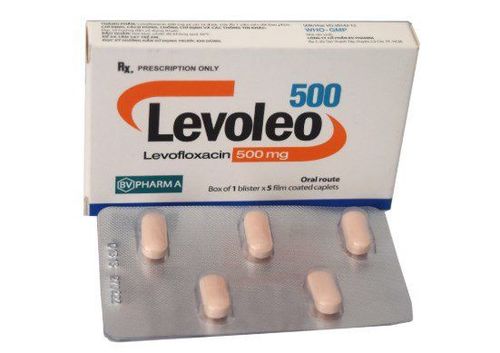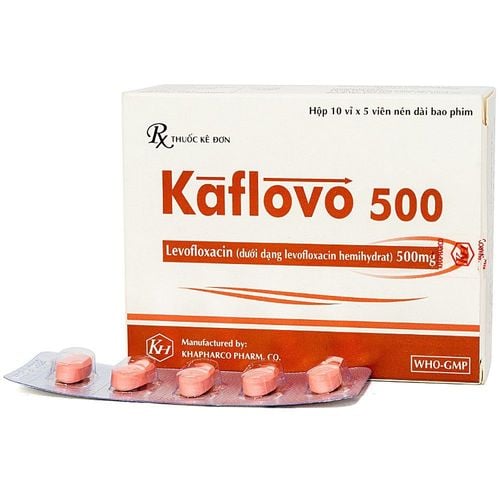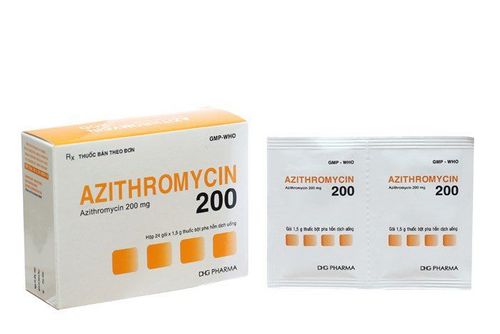This is an automatically translated article.
Nirdicin 250mg medicine has the main active ingredient Levofloxacin Hemihydrate. It is used to treat infections caused by bacteria sensitive to Levofloxacin.
1. What is Nirdicin 250mg?
Each Nirdicin 250mg tablet contains:
The active ingredient Levofloxacin (as Levofloxacin hemihydrate) is 250mg. Excipients 1 capsule. Nirdicin 250mg is prepared in the form of film-coated tablets.
Pharmacodynamics of Nirdicin 250mg:
Active ingredient Levofloxacin is a synthetic antibacterial fluoroquinolone for oral and intravenous administration. A fluoroquinolone antibacterial agent, levofloxacin inhibits bacterial DNA synthesis by acting on the DNA gyrase and topoisomerase IV complex. Levofloxacin is highly bactericidal. The spectrum of action of this antibiotic includes many Gram-positive and Gram-negative bacteria such as staphylococcus, streptococci, including pneumococci, enterococci, Haemophilus influenzae, non-fermenting Gram-negative bacteria and others. atypical bacteria. Pharmacokinetics of Nirdicin 250mg:
Absorption: After taking Nirdicin 250mg, Levofloxacin is rapidly absorbed. The bioavailability of the drug is almost absolute at about 100%. Food has little effect on drug absorption. Distribution: Approximately 30-40% of Levofloxacin is bound to serum proteins. Steady state concentrations are reached within 3 days. Nirdicin 250mg drug penetrates well into bone tissue, blister fluid or lung tissue, but poorly into cerebrospinal fluid. Metabolism: Nirdicin 250mg is very poorly metabolized, two metabolites account for <5% of the amount excreted in the urine. Elimination: Levofloxacin is eliminated from plasma relatively slowly (T1/2: 6-8 hours). The drug is excreted mainly by the kidneys (> 85% of the dose). With decreased renal function, renal clearance and elimination are decreased and the half-life is also increased (with creatinine clearance in the range of 20-40 ml/min with a T1/2 of 27 hours).
2. Effects of Nirdicin 250mg
The spectrum of action of Nirdicin 250mg:
– Bacteria are still susceptible
Gram-positive aerobic bacteria: Methicillin-sensitive Staphylococcus aureus (MSSA); Streptococcus pneumoniae ; Bacillus anthracis; Methicillin-sensitive Staphylococcus coagulase negative. Aerobic Gram-negative bacteria: Escherichia coli; Haemophilus influenzae; Haemophilus para-influenzae; Klebsiella pneumoniae; Legionalla pneumophila; Proteus mirabilis; Enterobacter cloacae; Moraxella catarrhalis; Pseudomonas aeruginosa. Anaerobic bacteria: Fusobacterium; Peptostreptococcus; Propionibacterium. Other bacteria: Chlamydia pneumoniae; Mycoplasma pneumoniae. - Levofloxacin-resistant bacteria:
Aerobic Gram-positive bacteria: Enterococcus faecium; Methicillin-resistant Staphylococcus aureus (MRSA); Methicillin-resistant Staphylococcus coagulase negative. There is a phenomenon of cross-resistance between the active ingredient Levofloxacin and other fluoroquinolones, but there is no cross-resistance between Levofloxacin and other groups of antibiotics. Therefore, for bacteria already resistant to Levofloxacin, fluoroquinolones should not be used for treatment, but need to be switched to other antibiotic groups.
3. What disease does Nirdicin 250mg treat?
Nirdicin 250mg is indicated in the treatment of infections caused by bacteria sensitive to Levofloxacin as follows:
Community-acquired pneumonia; Complicated urinary tract infections (including pyelonephritis); Chronic prostatitis; Skin and soft tissue infections; Uncomplicated urinary tract infections; Acute exacerbation of chronic bronchitis; Acute sinusitis.
4. Usage and dosage of Nirdicin 250mg
How to use Nirdicin 250mg:
Nirdicin 250mg is prepared in the form of tablets and used orally. Swallow the tablet whole with an adequate amount of water, do not chew or crush. The drug can be broken according to the line on the drug face to divide the dose. The time to use is at the time of the meal or between two meals. Dosage of Nirdicin 250mg drug prescribed by a doctor or refer to the therapeutic dose as follows:
For adults:
Community-acquired pneumonia: 2 tablets/time x 1-2 times/day for a period of time. period from 7 to 14 days. Skin and soft tissue infections: 1-2 tablets/time x 1-2 times/day for 7-14 days. Chronic prostatitis: take 2 tablets/time/day for 28 days. Complicated urinary tract infections such as pyelonephritis: take 1 tablet/time/day for 10 days. Uncomplicated urinary tract infections: 1 tablet/time/day for 3 days. Acute sinusitis: take 2 tablets/time/day for 10 to 14 days. Acute exacerbation of chronic bronchitis: take 1-2 tablets/time/day for 7-10 days. For people with renal failure, the treatment dose is based on creatinine clearance: Depending on the initial dose, there is a suitable treatment regimen.
Treatment in case of missed dose or overdose of Nirdicin 250mg:
In case of missed dose: Use that therapeutic dose as soon as you remember. Skip the missed dose if it is almost time for your next dose, take your next dose as scheduled. Never take twice the prescribed dose. In case of overdose: Signs of overdosage on the nervous system are tinnitus, confusion, mental disturbances, increased QT interval, and epileptic seizures. Signs of digestive disorders such as nausea, mucosal erosion. If you accidentally use an overdose and have serious unwanted effects, immediately go to the medical center for timely treatment.
5. Undesirable effects of Nirdicin 250mg
The possible undesirable effects include:
Common adverse effects: Diarrhea, nausea, increased liver enzymes, headache, insomnia. Uncommon side effects: nervousness, dizziness, agitation; constipation, vomiting, abdominal pain, flatulence, indigestion; hyperbilirubinemia, vaginitis, genital candidiasis; skin rash, itching. Rare adverse effects: Arrhythmia, changes in blood pressure, pseudomembranous colitis, gastritis, dry mouth, tongue edema. Some undesirable effects are encountered such as muscle fatigue, muscle weakness, joint pain, achille hepatitis, osteomyelitis. Rarely, depressive psychosis, abnormal dreams, convulsions after using the drug. If you see any unwanted effects during the use of Nirdicin 250mg, immediately notify the treating doctor or qualified pharmacist for timely handling.
6. Interactions of Nirdicin 250mg
Several interactions have been reported, including:
Preparations containing divalent and trivalent cations such as iron salts, antacids containing aluminum or magnesium: Nirdicin 250mg reduces the absorption of these drugs, so they should be taken at small intervals. at least 2 hours. Sucralfate: Levofloxacin bioavailability is reduced, so it should be taken about 2 hours after taking Nirdicin 250mg. Nirdicin 250mg drug affects renal excretion such as Cimetidine, Probenecid, especially in patients with renal failure: Use with caution. Vitamin K antagonists: Increase blood clotting time, bleeding time. To ensure safe and effective treatment, tell your treating doctor about all medicines, health foods you are taking and other diseases you have.
7. Some notes when using Nirdicin 250mg
Before using Nirdicin 250mg you need to carefully read the instructions for use and refer to the information below.
Nirdicin 250mg drug is contraindicated in the following cases:
People who are sensitive or allergic to Levofloxacin, Quinolone antibiotics and any excipients of the drug. People with epilepsy. Patients with a history of tendon pain associated with the use of fluoroquinolones. Children or adolescents under the age of 18 years. People with G6PD deficiency. Women who are pregnant and women who are breastfeeding. Note when using Nirdicin 250mg:
Achilles tendonitis often occurs in high-risk people such as the elderly (> 65 years old) and people who are taking corticosteroids, this complication can appear in 48 hours after using the drug, so caution should be exercised and dosage adjustment if necessary in the above subjects. At the first sign of tendinitis, such as pain and swelling, nirdicin therapy should be discontinued and alternative agents should be considered. There may be pseudomembranous colitis caused by Clostridium difficile causing diarrhea, which should be noted and handled appropriately and promptly. Levofloxacin increases photosensitivity, so you should not be exposed to direct sunlight or artificial UV rays during treatment and for 48 hours after stopping treatment to prevent skin inflammation. . Using preparations containing levofloxacin can cause sensory or motor polyneuropathy, so patients with symptoms of neuropathy such as pain, burning, and itching should inform their doctor. doctor before using Nirdicin. Hepatobiliary disorders may occur when using medicinal products containing Levofloxacin, especially in patients with underlying diseases, so if signs and symptoms of liver disease such as anorexia, jaundice, Dark, itchy urine should be reported to the doctor immediately. Superinfection may occur with prolonged use of Nirdicin 250 mg due to the growth of non-susceptible microorganisms, in which case appropriate measures should be taken. Note to special groups:
Ability to drive and use machines: Active ingredient Levofloxacin can cause unwanted effects such as tinnitus, dizziness, drowsiness and visual disturbances affecting the brain. ability to concentrate on driving or operating machinery. Pregnant women: Do not use preparations containing the active ingredient Levofloxacin for pregnant women. Fluoroquinolone antibiotics can cause damage to the growing organism's weight-bearing cartilage. Therefore, Nirdicin 250mg should not be used by pregnant women. Lactation: Do not use preparations containing Levofloxacin ingredient for nursing women. In summary, Nirdicin 250mg is used to treat infections caused by bacteria sensitive to Levofloxacin. Using the medicine exactly as prescribed by the doctor will help ensure the safety of the patient.
Please dial HOTLINE for more information or register for an appointment HERE. Download MyVinmec app to make appointments faster and to manage your bookings easily.













